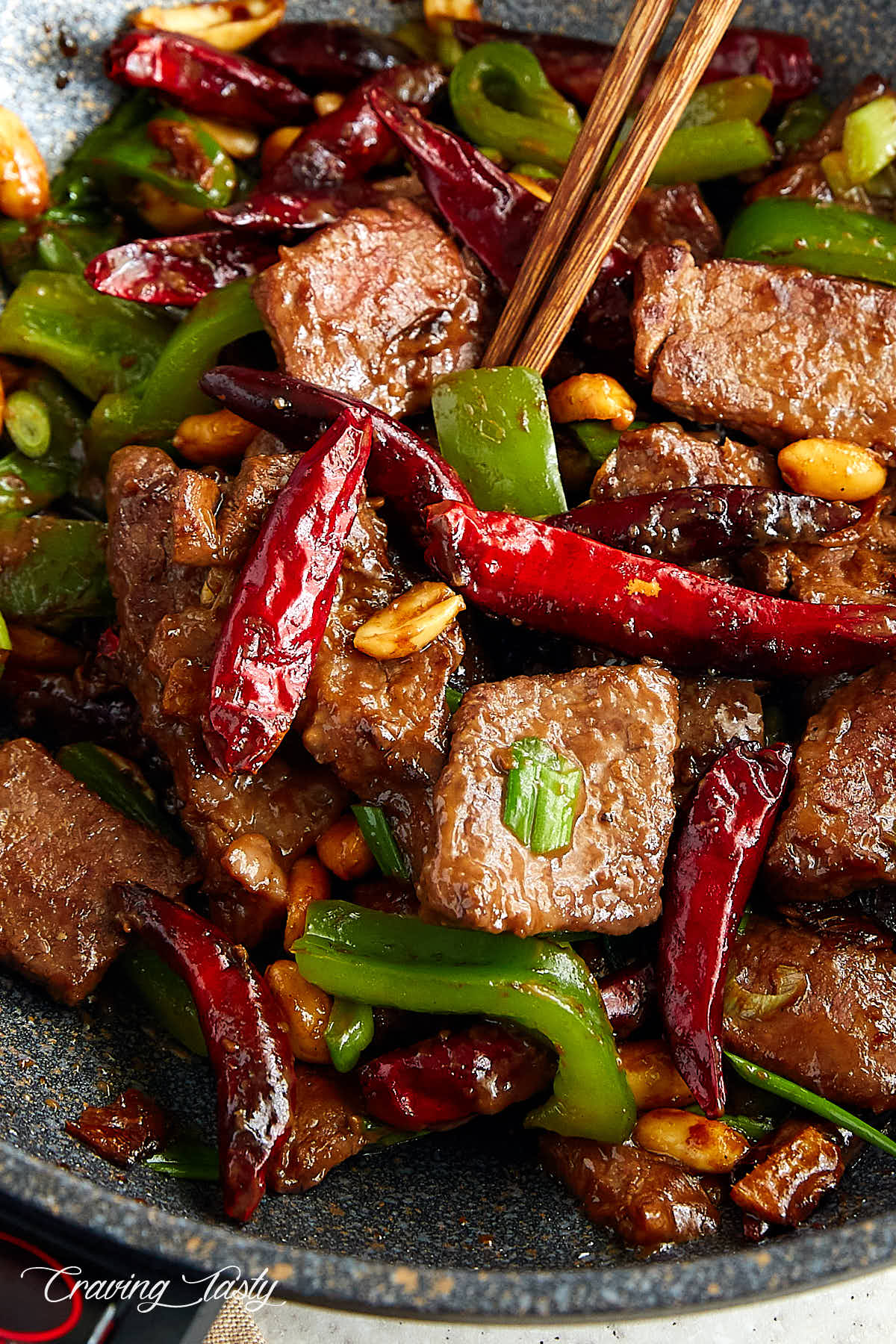 I must admit, I am a big fan of Kung Pao food - explosively fiery and mouth-numbing, with a subtle aroma of Szechuan peppercorns. If you like the real deal Kung Pao Chicken, you will love this Kung Pao Beef recipe. It's the real deal! But don't worry about it being overly hot and spicy, you can adjust the heat to your liking.
I must admit, I am a big fan of Kung Pao food - explosively fiery and mouth-numbing, with a subtle aroma of Szechuan peppercorns. If you like the real deal Kung Pao Chicken, you will love this Kung Pao Beef recipe. It's the real deal! But don't worry about it being overly hot and spicy, you can adjust the heat to your liking.
What is Kung Pao Beef?
Kung Pao Beef is a westernized version of the classic Szechuan dish called Kung Pao Chicken. Interestingly, many sources I've encountered note that Kung Pao Chicken is far more famous and popular outside of China than it is in the country that invented it. The dish features a full range of tastes and aftertastes: peppery hot and spicy, savory and slightly sweet and sour. It is said that Kung Pao Chicken was a favorite dish of a Szechuan governor during the Ch’ing dynasty (1644–1911), after whose official title, 'Kung Pao', the dish was named.
While I've been enjoying spicy food for a long time, Kung Pao is something I became fond of only recently. The reason for that is how this dish was made. Overly sticky, unnecessarily sweet and bland is how I remember Kung Pao that I tried at local Asian food places. Are we, westerners, supposed to like food like that?
About this recipe
Thankfully, it all changed when I tried Bee Yin Low's Gong Bao Ji Ding (Kung Pao Chicken) recipe published in her Easy Chinese Cooking book. I'll admit, I haven't had a chance to travel to China and experience authentic food there, but that Kung Pao Chicken blew me away. I enjoyed every last bit of it, making it over and over again in the following weeks, until I finally satisfied my cravings.
This Kung Pao Beef recipe is based on Bee's original Kung Pao Chicken and the Szechuan Chicken recipes that I enjoyed. And let me tell you, the result is absolutely fantastic!

Tips and tricks for making kung pao beef
Following Szechuan cuisine traditions (that's why I think of this recipe as traditional) I am using Szechuan peppercorns for flavor and that numbing feeling, as well as hot pepper oil for heat. Traditionally, Kung Pao dishes are served with lots of dried red chilies, but they are not necessarily the source of heat. If you follow my recipe, they won't add much heat, if any. For that to happen you would need to break them and release the source of heat, the seeds, into the food. We won't do that. We will keep them intact and stir-fry gently, without breaking them. You can also cut them in half and de-seed prior to cooking, but I find that hardly necessary.
Another mandatory attribute of Kung Pao Beef dish is roasted peanuts. Lot's of them. That toasty, nutty flavor adds complexity, and the crunchy texture adds a nice contrast to the tender beef. However, if necessary for health reasons, you can skip this ingredient.
I find stir-fried vegetables a very welcome addition to King Pao Beef. My favorite ones are green bell peppers. But I vary them, from green beans to snow peas, to asparagus and many other. You can't be wrong here. Just use whatever you like. A dish always tastes best when it's made of ingredients that you like.
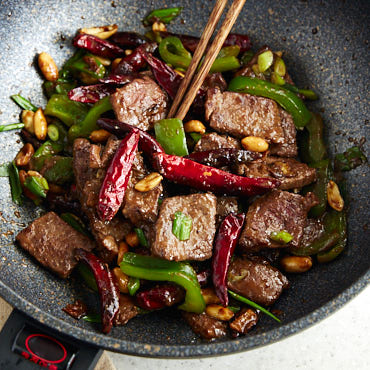
Ingredients
- 1 lb beef short rib meat (flank steak or beef tenderloin, sliced into 1/4" thick strips)
- 1 green bell pepper (cut into 1/2" x 1" pieces)
- 2 Tbsp cooking oil (for stir-frying; peanut oil recommended)
- 3 cloves garlic (thinly sliced)
- 1 inch ginger root (peeled and thinly sliced)
- 10 dried red finger-length hot chilies
- 3 Tbsp roasted peanuts
- 1/2 tsp finely ground Szechuan peppercorns (I like grinding in a mortar with a pestle)
- 3 green onions (cut into small rounds)
For the marinade:
- 1 Tbsp Shaoxing rice wine
- 1 Tbsp cornstarch
For the sauce:
- 2 Tbsp low sodium soy sauce
- 1 tsp dark soy sauce
- 2 tsp Chinese black vinegar
- 1 tsp Shaoxing rice wine (or sherry wine)
- 1/2 tsp white sugar
- 1/8 tsp white pepper
- 2 Tbsp water
- 1/2 tsp cornstarch
For the Szechuan Peppercorn Oil and Hot Chili Oil:
- 2 Tbsp Szechuan peppercorns
- 2 Tbsp dried red chili flakes
- 1/2 cup oil (any oil will work, though my favorite is peanut oil)
Instructions
- To prepare Szechuan and hot chili oils, place two tablespoons of Szechuan peppercorns and two tablespoons dried red chili flakes into two separate small bowls. Heat the oil until it just starts to smoke. Pour half of the oil into each bowl. Let cool down, then strain into separate containers. The oils can be made several days in advance.
- Place the sliced meat into a bowl. Add the rice wine and cornstarch, and marinate for 10 minutes.
- Mix the ingredients for the sauce in a small bowl and set aside.
- Heat 1/2 tablespoon of the oil in a wok or skillet and stir-fry the marinated beef strips until they are nicely browned and almost cooked. Remove the meat and set aside.
- Add another 1/2 tablespoon of the oil. Add the bell pepper and stir-fry for about 2 minutes, until slightly charred and softened up. Remove from the wok and set aside.
- Heat the remaining oil, plus 1 tablespoon Szechuan Peppercorn Oil and 2 teaspoons Hot Chili Oil (see note) in the wok or a skillet. Add the sliced garlic and ginger, stir quickly for a few seconds, then add the dried red chilies. Stir-fry until you smell the spicy aroma of the dried chilies.
- Return the beef and the bell pepper pieces to the wok or skillet and stir quickly with the spatula. Add the sauce and keep stirring until the beef is nicely coated with it. Sprinkle ground Szechuan peppers, stir in the roasted peanuts and the green onion.
- Remove from the wok or skillet and serve immediately with steamed rice.
Notes
1-2 tsp for mild heat
3-4 tsp for medium heat
5+ tsp for high heat
Nutrition


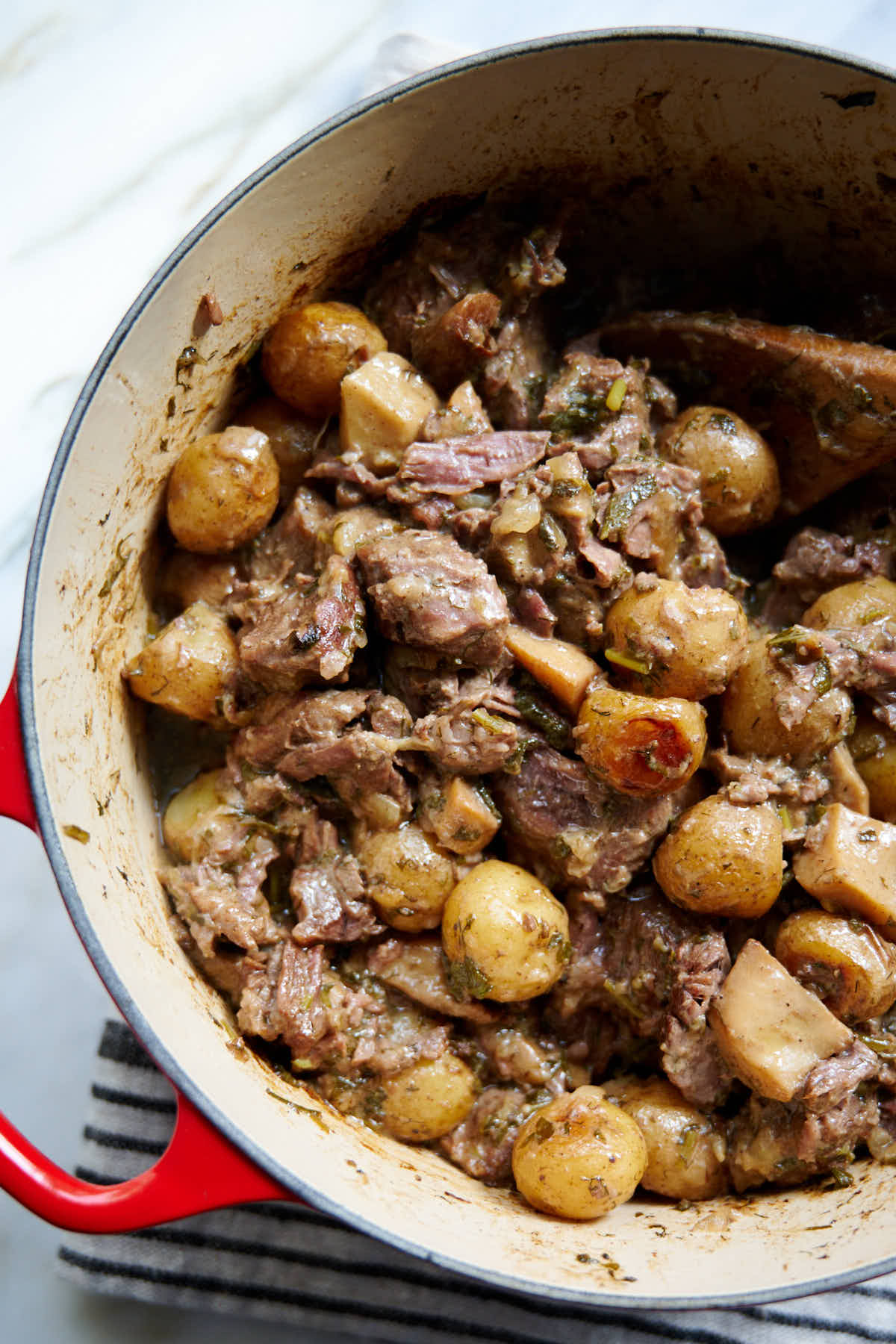
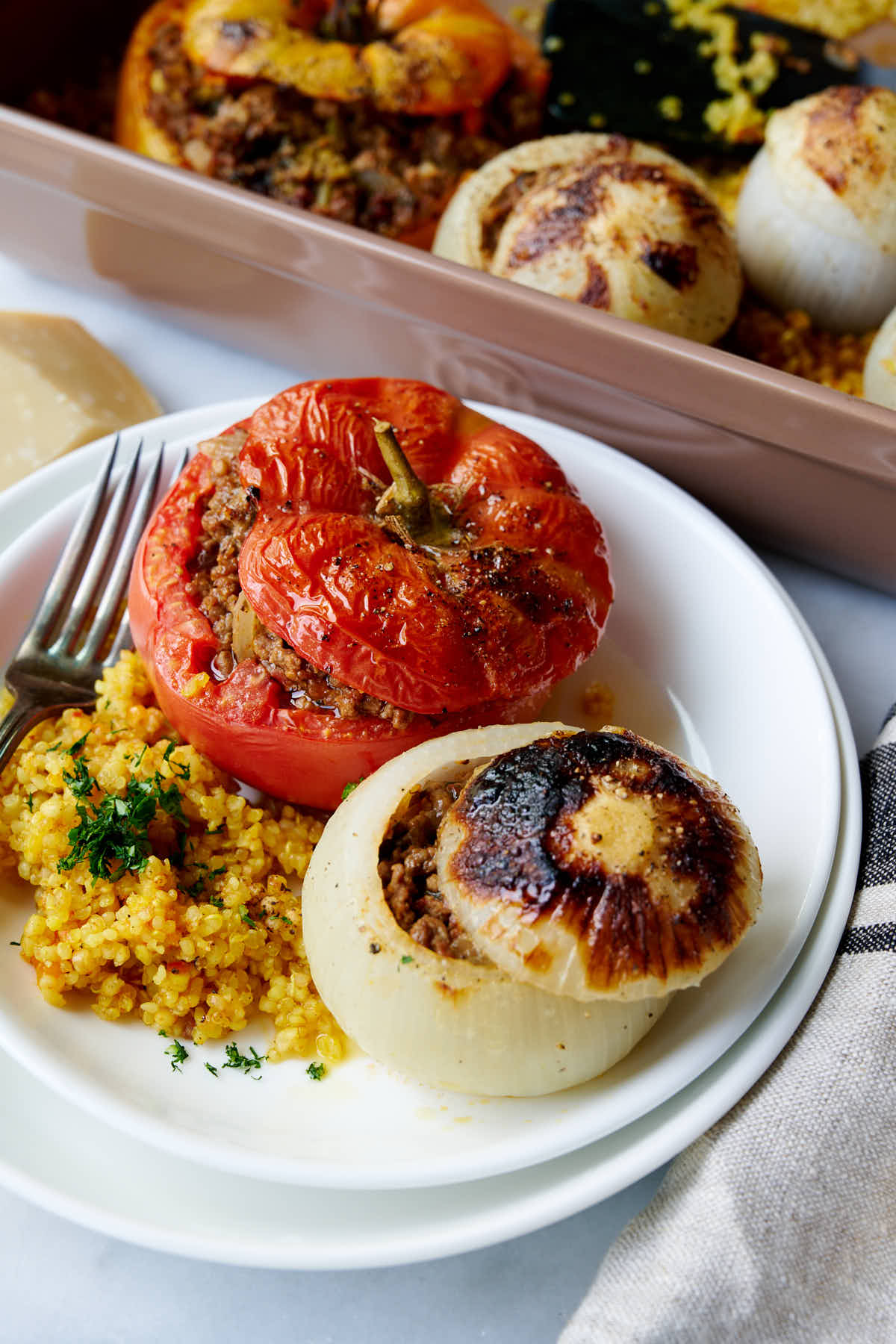
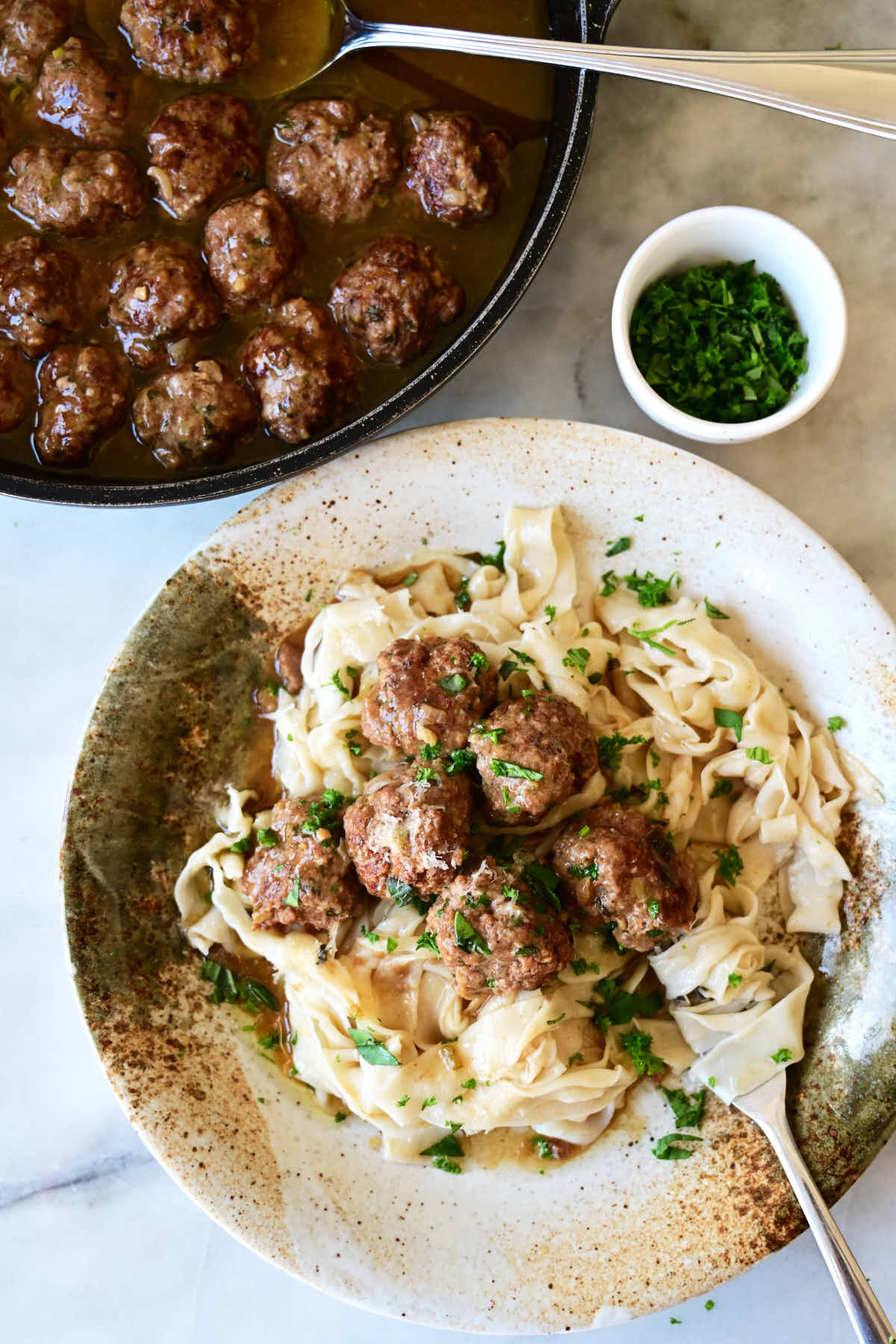

Jon says
Gongbao Beef is actually authentically Chinese. I lived in Kunming, China and I got that dish almost every day for the better part of 4 months... It was definitely better than Gongbao Chicken, thought that's still good.
I lived in a few other cities after that and I could not find that dish anywhere else... which really sucks because the best thing I ate in all my 4 years in China was that Gongbao Beef in the little shop across the street from my apartment.
There is a green melon or cucumber like veggie that they use instead of the green peppers (haven't been able to find here and can't believe I forgot to ask what it was when I was there), and they always use green onions and/or leaks.
Lay this over some freshly made rice.
victor says
Interesting. Thanks for the info, Jon.
duffy dennis says
Sounds Delish! Love recipes that attempt at creating close to authentic flavorings.
Hanim says
So delicious. I have tried this recipe and will try again in the future
Jayne says
Excellent! Like most stir fry recipes, it pays to have everything cut and the sauce elements prepared before you heat the skillet/wok. With a few minutes prep, this is a fast, nutritious and deliciously spicy dinner that’s fast enough for weeknights and tasty enough for company! I had some snow peas and baby book Choy on hand that I added after the peppers.
Destinee says
Where did you find Chinese black vinegar? We've had a hard time locating it! Thank you!
victor says
Buy it from a local Asian grocery store. It's used widely in Chinese cooking.
Darryl says
Szechuan = Sichuan
Ch’ing = Qing
Kung Pao = Gong Bao
It's extremely famous in China, surely moreso than outside of China - it's only really well known in America
You should skip the green peppers and use green onion / leeks instead.
Steve J. says
Made this tonight – it was a huge hit! My wife said it tasted just like something you’d get from Chinatown.
So yummy and satisfying!
Brad says
After trying several recipes for Kung Pap Beef I find this one is my favorite. It tastes very good and easy to make. Will be making again for sure.
Quinn Barnes says
Excellent! Thanks for sharing...
Robin says
One of a kind. Delicious.
Aldo says
Fantastic meal. So delicious.
Made a double batch then a double double batch. Nothing left.
victor says
Great to hear that, Aldo. This is one of my favorite beef recipes by far.
Barbara says
Delicious!
Ann-Marie says
DELICIOUS!!! Made this twice this week for my family and everyone loved it.
Gigi Clark says
Don't you think this is hot food and not suitable for summers? 🙂
victor says
Have you noticed how the further South you travel the spicier and hotter the food gets? Like, Canada vs Mexico. Russia, vs Tajikistan, vs Pakistan, vs India? I'll take spicy any day, winter or summer.